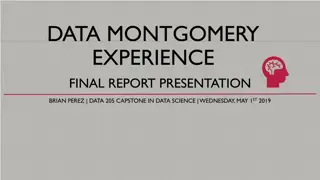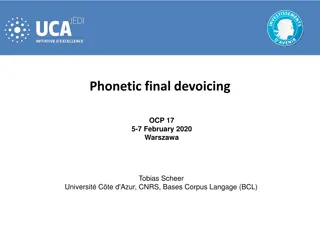Access Living: Cultivating Racial Justice and Inclusion
Access Living, a Chicago-based organization, has been proactively addressing the intersection of race and disability since 2008. Through intentional efforts like immediate staff discussions, trainings, consulting, and establishing a racial justice council, Access Living is committed to fostering cultural competency and advancing racial justice within the organization.
Download Presentation

Please find below an Image/Link to download the presentation.
The content on the website is provided AS IS for your information and personal use only. It may not be sold, licensed, or shared on other websites without obtaining consent from the author. Download presentation by click this link. If you encounter any issues during the download, it is possible that the publisher has removed the file from their server.
E N D
Presentation Transcript
Independent Living Research Utilization Independent Living Research Utilization 1
Creating Supportive Organizational Creating Supportive Organizational Culture and Culture and Infrastructure Infrastructure Daisy Feidt, Reyma McDeid, Liz Sherwin, Daisy Feidt, Reyma McDeid, Liz Sherwin, and Jesse Bethke Gomez and Jesse Bethke Gomez 2
Daisy Daisy Feidt Access Living Access Living Feidt 3
I feel like everything we do is a work in I feel like everything we do is a work in progress . We are a little uncomfortable with progress . We are a little uncomfortable with being raised as the icon on this issue because we being raised as the icon on this issue because we still have a long way to go. still have a long way to go. ~ ~ Marca Marca Bristo Access Living (Chicago, IL) Access Living (Chicago, IL) Bristo, President and CEO , President and CEO 4 4
Background Background Access Living Access Living Established in 1980 Service area is City of Chicago 60 staff Reach approximately 1800 consumers annually Budget is approx. 6 million 5
Access Living Access Living Started tackling the intersection between race and disability in a very intentional way in 2008. Two race-related incidents occurred at Access Living. These incidents caused issues that were bubbling below the surface to spill over in a big way. Developed a plan to take organization through a process of learning and (we hoped ) growth. 6
Access Living Access Living Process Immediate staff discussion on incidents with facilitator. Trainings for staff on race and disability intersection. Consulting for management with D&I (Diversity and Inclusion) consultant. Setting up a staff-led racial justice council that included all levels of staff from all departments to discuss issues and create an action plan for improved cultural competency on race. Staff retreat in which one of the main topics was what racial justice looks like in the context of Access Living. Process 7
Mission and Values Mission and Values Access Living Access Living Mission: Access Living ignites the power and pride of people with disabilities, provides critical services, and breaks down systemic barriers to create a more inclusive, and therefore much stronger, society. Diversity, Equity and Inclusion Values Equity, Inclusion and Justice We believe in our collective journey toward a healing and transformative justice. In order to advance this journey, we seek a diversity of voices and identities, equitable access to resources and opportunities for all, and full inclusion of people with disabilities in all aspects of society and life. 8
Mission and Mission and Values Values, cont d. Cross-Disability and Intersectional Perspective Access Living is a cross-disability organization governed and staffed by a majority of people with disabilities whose decisions are made by people with disabilities. People with disabilities are a significant part of every other identity group including age, race, sexual orientation, gender identity, class, religion, and ethnicity. Access Living is committed to all members of our community, to the knowledge that intersectional identities matter, and that our work continually strives to be fully inclusive of all types of disabilities. 9
Policies & Policies & Procedures Procedures Access Living Living Had non-discrimination policy since the 90 s. Staff-led racial justice council looked at Human Resource policies through a racial justice lens. Most significant change was to wage and salary determinations. More emphasis on experience, less ability for job candidates to negotiate salary. Access 10
Engaging Board and Staff Strategic Engaging Board and Staff Strategic Planning Planning Strategic planning can move everyone toward important goals related to diversity and inclusion. Can be an important first step in engaging board and staff. It gives key people in your organization permission to focus on D&I + accountability measures. Helps change the dynamic from something people in your organization think of as important, but is somewhat tangential to your key goals, to something that becomes part and parcel of the work you are doing. Can also create an opportunity to refresh values, vision and mission. 11
Engaging Board and Staff Strategic Engaging Board and Staff Strategic Planning, Planning, cont d. Strategic plan goals can include things like: Increasing board diversity to match service area. Increased outreach to underserved community (e.g. Latinx). Create strategic partnerships with organizations who serve specific underserved constituencies. Apply a racial equity framework to the work we do to ensure equitable access to resources and opportunities for all. 12
Strategic Plan Goals Strategic Plan Goals Strategic plan goals around diversity and specific goals in Access Living s strategic plans have led to: Latinx s with disabilities project that is currently focused on immigration issues. Racial justice organizer. Much more racially diverse board. 13
Intentional Staff Engagement Intentional Staff Engagement Train staff on intersections of disability and race. Change recruitment practices ask local companies for help. Change onboarding process to reflect importance and set tone from the beginning. Ask questions in interviews with prospective staff to let them know this is important and to make sure the fit is right. Respond to race-related events that are occurring in the world. 14
Staff Engagement, Staff Engagement, cont d. Consider creating internal committee to address issues, especially if you have people of color as non-managers and very few managers of color. Create actionable goals with accountability mechanism. Sample goals: 1) Increase racial diversity of the staff to reflect demographics of CIL location. 2) Conduct town halls on the intersection of disability and race. 15
Getting the Board on Board Getting the Board on Board One of the action items the staff-led racial justice council set was to increase the racial diversity of our board. This also became a strategic plan goal. We set a target for race diversity to match the make- up of the City of Chicago. We attended trainings, with key board members, on how to increase board diversity. Nominating committee chair developed nomination guidelines that made clear our intention to focus on increasing the diversity of our board. Guidelines were approved by full board. 16
Getting the Board on board, Getting the Board on board, cont d. Strategies for success: Set targets. Ensure board is trained on importance and the how. Use available resources some areas have services to address this need. Consider hiring consultant. Create unifying vision statement. If needed, garner support from key board members first so they can help the entire board to understand importance. 17
Getting the Board on Board Getting the Board on Board Lessons Learned Lessons Learned Can t lose focus on the goal, even when goal is reached. Constant networking is required. Gets easier once you have critical mass. While recruiting, need to be explicit about what you are looking for and why. 18
Achieving Organizational Culture Change Achieving Organizational Culture Change Change make-up of staff/board. Leadership must model shift in mindset of organization. Expect resistance and have a plan to address. Intentionally hire people who will keep organization accountable. Must have mind set that intersectional issues are disability issues. Must be open to doing the work. Will likely be surprised at how much there is to do. I know we were/are. 19
Reyma McCoy McDeid Reyma McCoy McDeid Central Iowa CIL Central Iowa CIL 20
Mission/Vision Mission/Vision Statements Original mission: To empower people with disabilities to lead barrier-free lives. Updated mission: To empower people with disabilities to be accountable in controlling their own lives. Statement was revised to recognize the reality that no one truly leads a barrier-free life, so a mission as such would be unrealistic. Statement reflects feedback from CICIL clients, many of whom indicated that the more layers of diversity they experience, the less likely they felt society recognized the feasibility of their autonomy & personhood. Statements CICIL CICIL 21
Mission/Vision Mission/Vision Statements cont d. Original vision: Prior to 2015, CICIL lacked an articulated vision statement. Current vision statement: A community that is inclusive of people with disabilities at every level, including leadership. Vision statement crafted as the result of overwhelming feedback regarding the tokenization of people with disabilities in society being seen as inclusion. Statements CICIL, CICIL, 22
Policies & Policies & Procedures Procedures CICIL CICIL No policies/procedures existed prior to 2015. Bylaws, prior to 2016, had not been revised since 2008. CICIL recruited an HR executive to join the board and assist in drafting policies/procedures. Personnel policies drafted to include nondiscrimination, anti-harassment, and EEOC terminology. Client policies drafted to include, in addition to the above, policies on capturing LGBTQ+ specific data (on a voluntary basis) and commitment to meeting the peer support needs of a diverse service population. 23
Policies & Procedures Policies & Procedures CICIL CICIL, cont d. Bylaws drafted to include provision of a commitment ensuring a diverse board, above and beyond the federal mandate regarding disability representation. Board application, code of conduct, nondisclosure form, conflict of interest statement, and goals/expectations agreement drafted to streamline the board member recruitment/selection process. 24
Policies & Procedures Policies & Procedures CICIL CICIL, cont d. 2 All CICIL staff have been certified to provide Customized Employment (CE) to job seeking clients (Supported Employment job development, job coaching, job retention is the primary service currently offered at CICIL). CE currently doesn t offer specific guidance on customizing supports in a culturally competent manner; CICIL has, as a result, formulated procedures and guidelines to ensure that supports take into account a client s race, sexual orientation, religion, gender identity, and/or any other factor that is important in a client s life. 25
Engaging the Engaging the Board Board CICIL CICIL CICIL s board experienced 100% transition between 2015-2017. Several members left due to desire to pursue other projects, two retired, one resigned, and one was unanimously voted off of the board. CICIL was able to recruit members who had skill sets that aligned with CICIL s evolving needs and who presented facets of diversity that mirrored the organization s demographics. 26
Contact Contact Daisy Feidt DFeidt@accessliving.org Reyma McCoy McDeid Reyma@CICIL.org Jesse Bethke Gomez jessebg@mcil-mn.org Liz Sherwin liz@iicil.com 27
CIL CIL- -NET Attribution NET Attribution This project is supported by grant number 90ILTA0001 from the U.S. Administration for Community Living, Department of Health and Human Services, Washington, D.C. 20201. Grantees undertaking projects under government sponsorship are encouraged to express freely their findings and conclusions. Points of view or opinions do not, therefore, necessarily represent official Administration for Community Living policy. 28







![READ⚡[PDF]✔ Yup I'm Dead...Now What? The Deluxe Edition: A Guide to My Life Info](/thumb/20463/read-pdf-yup-i-m-dead-now-what-the-deluxe-edition-a-guide-to-my-life-info.jpg)


















